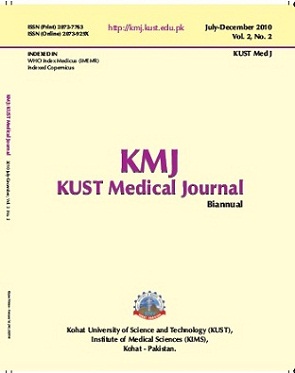The Role of Fine Needle Aspiration Cytology (FNAC) in the Management of Solitary Thyroid Nodules.
Main Article Content
Abstract
ABSTRACT
Objective:To determine the sensitivity, specificity and diagnostic accuracy of fine needle aspiration cytology in the management of solitary thyroid nodule.
Material and Methods:This prospective study was conducted in the ENT Department, Hayatabad Medical Complex, Peshawar from January 1, 2007 to December 31, 2009. A total of 60 patients presenting with solitary thyroid nodule were included in the study. All the patients underwent fine needle aspiration of the nodule followed by excision biopsy. A comparison of FNA cytology and biopsy results was made.
Results: Mean age of patients was 35.7+11.04 years with age ranged from 20 to 70 years. The male: female ratio was 1:4. The FNAC showed benign in 44 (77.3%), malignant in 8 (13.3%) and suspicious to be malignant in 8 (13.3%)cases and the biopsy revealed benign in 47 (78.3%) and malignant in 13 (21.7%) cases. The results obtained on FNAC were compared with those obtained from biopsying the respective specimens. The diagnostic value of FNAC in solitary thyroid nodule was; accuracy 88%, sensitivity 85%, specificity 90%, positive predictive value 69% and negative predictive value 95%.
Conclusion: FNA cytology is able to distinguish reliably between benign and malignant thyroid nodules. It is recommended to evaluate preoperatively every solitary thyroid nodule initially with the help of this technique. However in view of a small number of false negative results, the FNA results should be interpreted in the light of clinical findings. In case of doubt the true nature of the disease should be confirmed by biopsy.
Key Words: Solitary Thyroid Nodule, Fine Needle Aspiration Cytology, Histopathology, Sensitivity, Specificity.
Article Details
Work published in KMUJ is licensed under a
Creative Commons Attribution 4.0 License
Authors are permitted and encouraged to post their work online (e.g., in institutional repositories or on their website) prior to and during the submission process, as it can lead to productive exchanges, as well as earlier and greater citation of published work.
(e.g., in institutional repositories or on their website) prior to and during the submission process, as it can lead to productive exchanges, as well as earlier and greater citation of published work.
